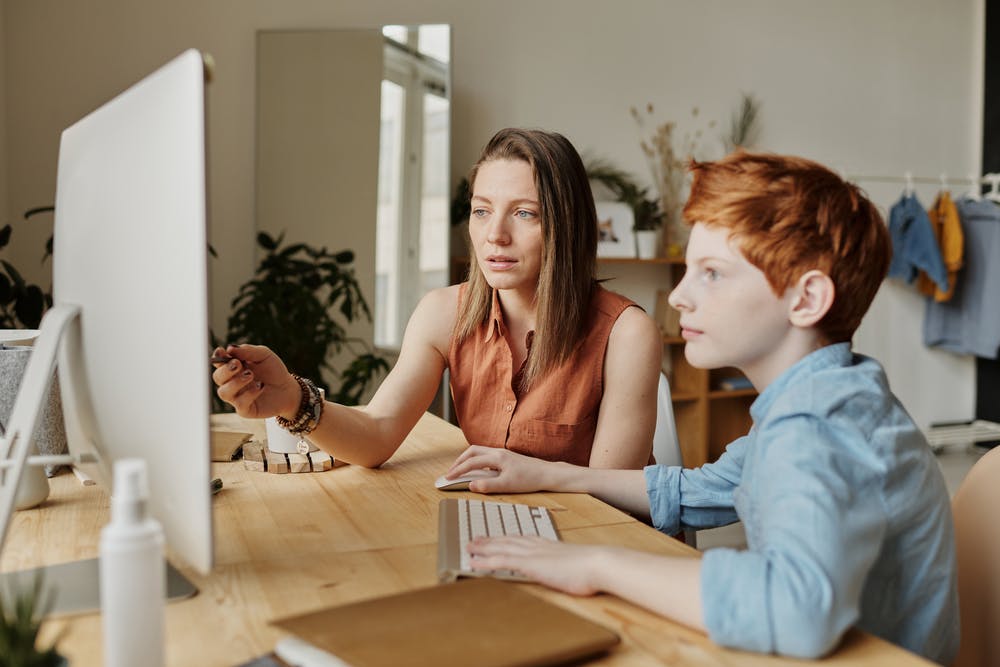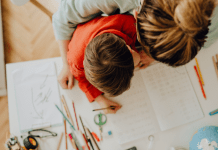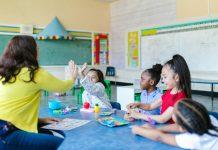It’s 8:40 a.m. on a recent Thursday morning. Here’s what’s going on in my house.
My kindergartener is at the breakfast table, singing the “Days of the Week” song (to the tune of The Addams Family theme) at full volume along with her classmates in Zoom circle time.
My 4th grader is in the living room following along to a Minecraft-themed HIIT workout video for P.E. credit.
My 7th grader is at the dining room table diagramming sentences along with her classmates in her Zoom English class.
My 10th grader is in my home office, sipping her 2nd cup of coffee while she measures angles along with her classmates in her Zoom Geometry Honors class.
 And me? I’m frantically running between the 4 of them, acting as tech support and teacher, all while trying to get my own work done. And feeling like a frazzled failure.
And me? I’m frantically running between the 4 of them, acting as tech support and teacher, all while trying to get my own work done. And feeling like a frazzled failure.
We are starting off the new school as we ended the last, distance learning. And it’s still a struggle, perhaps more so now because the kids have not met their teachers or classmates yet.
The plan is for on campus learning after Labor Day. But if 2020 has taught us anything, it is that we have no idea what might happen.
Many of my friends, desperate to avoid the distance learning challenges of the past spring, have started forming learning pods.
A learning pod is parents getting together to provide a group environment for their kids to work on distance learning, with parents taking turns supervising the kids. The kids get to socialize, and the parents can get much-needed breaks to take care of work or household chores.
Here’s what you need to know if you are considering forming a learning pod.
Be selective with who is in your learning pod
Pods work best if all of the kids go to the same actual school so everyone is using the same eLearning platform.
In addition to being in the same school, you should also try and pair up with families you know well. For pods to work, there needs to be a certain level of trust amongst the parents.
Speaking of knowing the other parents well, make sure everyone is on the same page with social distancing rules. A family who has little face-to-face contact with people outside of their household is not going to be comfortable working with a family who is lax about social distancing.
Finally, limit the number of people in your pod so you can properly space kids out in the shared space and comply with local mandates. The fewer people involved, the less risk you will be taking. A pod formed by a friend of mine chose 10, meaning 8 kids working together plus the 1 or 2 parents supervising the kids.
Establish guidelines for your pod
Once you have assembled your pod, now it’s time to get down to the nitty-gritty details of how the pod is going to operate.
Parents will need to create a designated learning space in their homes large enough to accommodate all kids, considering proper distancing.
You will need to come up with detailed schedules, such as drop and pick up times and breaks.
Finally, the parent(s) in charge on a particular day must agree to provide both tech and educational support for all of the kids in their care.
Remember to follow safety protocols
Distance learning is intended to reduce exposure. Make sure your pod guidelines include basic safety protocols such as:
• frequent handwashing with soap and water;
• no sharing of food, snacks, or drinks;
• spending as much time as possible outdoors;
• each child having their own designated set of school supplies; and
• cleaning the space and regular sanitation of high-touch areas.
In addition, no child should attend if they are sick, or if they have tested positive for COVID or been exposed to someone who has tested positive (and remain home for the proper quarantine period).
Be mindful of potential pitfalls
Make sure you have adequate liability insurance to cover any accidents that might happen in your house (e.g., child tripping and hitting her head).
If you decide to hire an outside teacher or tutor to work with the kids, you have a whole new set of issues to consider.
In addition to the process of selecting the right person (including proper background checks), you have to figure out how they will be paid and how they will be monitored. Also, as with the hiring of any person, there are tax and insurance implications you should discuss with your accountant. Finally, there is additional liability exposure for the host family if a child is injured or harmed by the teacher or tutor while the child is in the host family’s house.
Until schools can safely physically reopen, learning pods can be an option for parents to deal with the challenges of distance learning.













